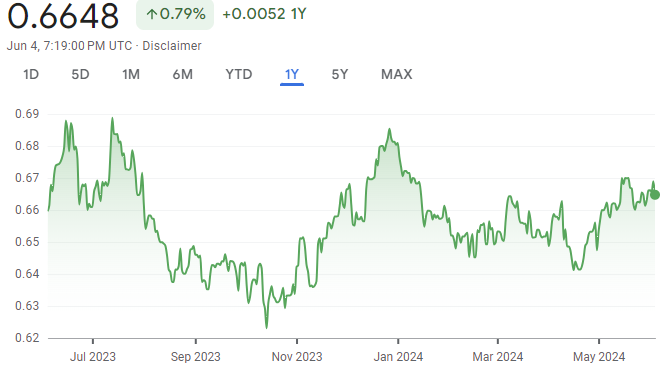Australian Dollar Forecast: Will the Aussie Dollar Rebound later in 2024?

The Australian dollar (AUD) has experienced significant fluctuations over the past few years. As we look towards the end of 2024, the question on every investor’s mind is whether the Australian dollar exchange rate will recover, especially now that Central Banks elsewhere in the world are starting to lower interest rates.
At the beginning of 2023, the Australian dollar started on a high note, reaching 0.71 US cents for one Australian dollar. However, this optimism was short-lived as the currency declined steadily, ending the year at 0.67 US cents. The AUD/USD pair hovered between 0.64 to 0.66 US cents in early 2024. With speculations about rate hikes by the Reserve Bank of Australia (RBA) and potential rate cuts by the US Federal Reserve (Fed), the forecast for the Australian dollar remains a hot topic.
What Factors Can Influence the Australian Dollar Exchange Rate?
Interest Rates and Monetary Policy
Interest rates play a crucial role in the Australian dollar forecast. The RBA raised the cash rate to 4.35% in November 2023, maintaining this level into 2024. This decision was influenced by persistent inflation and strong domestic economic data. On the other hand, the Fed, after holding its rates at 5.5%, is expected to start cutting rates later in 2024. This divergence in monetary policy could strengthen the AUD, making it more attractive to investors seeking higher returns.
The RBA’s decision to maintain or adjust interest rates will be closely watched. A higher cash rate typically makes the Australian dollar more appealing as it offers better returns compared to other currencies. Conversely, if the Fed cuts rates as expected, the USD forecast exchange rate could weaken, providing further support for the AUD/USD exchange rates.

Economic Data and Domestic Conditions
Australia’s economic performance, including inflation, consumer spending, and labor market figures, significantly impacts the future changes in AUD. Recent economic data indicates robust wage growth, albeit not keeping pace with inflation. This discrepancy fuels speculation about the RBA’s future rate hikes, which could support the Australian dollar exchange rate.
Inflation also remains a critical factor. If inflation continues to rise, the RBA might be compelled to increase interest rates further, strengthening the Australian dollar. On the other hand, a decline in inflation could lead to a more dovish stance, potentially weakening the AUD.
Commodity Prices
Australia’s economy is heavily reliant on commodity exports, particularly iron ore. Fluctuations in commodity prices directly impact the demand for Australian dollars. As global demand for commodities remains strong, the AUD benefits from higher export values. However, any downturn in commodity prices could negatively affect the AUD forecast.
Iron ore, being Australia’s largest export, plays a significant role. High iron ore prices boost Australia’s export earnings, thereby increasing demand for the Aussie dollar. Conversely, a decline in iron ore prices can reduce export revenues and weaken the AUD.
Global Economic and Geopolitical Factors
Ongoing global crises, such as geopolitical tensions, trade disputes, and economic instability, influence the AUD/USD exchange rate. The US dollar’s status as a “safe haven” currency means that in times of global uncertainty, investors flock to the USD, often at the expense of the AUD. Additionally, the upcoming US presidential election and its potential impact on US-China relations could further affect the Australian dollar’s performance.
Geopolitical risks, such as the Russian invasion of Ukraine or tensions in the Middle East, can lead to market volatility. In such scenarios, the demand for safe-haven assets like the US dollar increases, which can negatively impact the AUD. However, periods of global stability and positive economic developments can potentially strengthen the Aussie dollar.
Six-Month and Twelve-Month Forecasts for AUD/USD
Six-Month Forecast
Major banks have varied predictions for the AUD/USD exchange rate in the coming months. Westpac predicts the AUD will be worth 0.68 US cents by June 2024, while NAB forecasts a slightly higher rate of 0.69 US cents. ING, on the other hand, remains more conservative with a forecast of 0.66 US cents.
These forecasts are influenced by several factors, including interest rate expectations, commodity prices, and global economic conditions. For instance, if the RBA continues its hawkish stance while the Fed cuts rates, the AUD/USD pair could see an upward trend. Conversely, if global economic conditions worsen, the demand for the US dollar as a safe haven could increase, putting downward pressure on the AUD.
Twelve-Month Forecast
Looking further ahead, banks remain optimistic about the Australian dollar. Westpac expects the AUD to reach 0.70 US cents by December 2024, while NAB forecasts 0.72 US cents. These predictions hinge on the anticipated rate cuts by the Fed and sustained economic growth in Australia.
The twelve-month forecast takes into account the broader economic outlook and potential policy shifts by central banks. A stable domestic economy, coupled with favorable commodity prices and a dovish Fed, could support a stronger AUD to USD exchange rate. However, geopolitical risks and global economic uncertainties remain significant factors that could influence these predictions.
The Role of the Reserve Bank of Australia
Its monetary policy decisions, particularly regarding interest rates, are closely watched by investors. The RBA’s current stance is to maintain the cash rate at 4.35%, with potential rate hikes later in 2024 if inflation persists. This approach contrasts with the Fed’s expected rate cuts, which could favor the AUD.
The RBA’s statements and economic assessments provide valuable insights into its policy direction. For example, the central bank has indicated that inflation remains a concern, suggesting that further rate hikes could be on the horizon if inflation does not moderate. Investors will be keenly monitoring the RBA’s meetings and reports for any signals regarding future monetary policy actions.
The Impact of China’s Economic Slowdown
China is Australia’s largest trading partner, and its economic performance significantly affects the AUD. Recent data shows slower growth in China’s economy, with lower-than-expected GDP growth and cautious domestic spending. However, positive signs, such as improved industrial production and factory activity, offer some hope. A strong Chinese economy typically boosts demand for Australian exports, supporting the Australian dollar exchange rate.
China’s economic health is crucial for Australia, given the strong trade links between the two countries. Any slowdown in China’s economy can reduce demand for Australian exports, particularly commodities like iron ore, which in turn can weaken the AUD. Conversely, robust economic activity in China can drive demand for Australian goods, supporting a stronger AUD/USD exchange rate.
Commodity Prices and Their Influence
Commodity prices, particularly iron ore, remain a critical factor for the AUD. High commodity prices increase Australia’s export earnings, boosting demand for the Aussie dollar. Conversely, a decline in commodity prices can weaken the AUD.
Other commodities, such as coal and gold, also play a role in determining the AUD’s value. Australia’s resource-rich economy means that fluctuations in global commodity prices can significantly impact the AUD/USD exchange rate. A sustained increase in commodity prices can lead to a stronger Australian dollar, while a decline can have the opposite effect.
Historical Analysis and Future Projections
Historically, the AUD/USD exchange rate has averaged around 0.70-0.75 US cents. Significant drops occurred during global crises, such as the COVID-19 pandemic and the Global Financial Crisis. Despite recent declines, the long-term outlook for the AUD remains optimistic, with predictions of a gradual recovery throughout 2024 and beyond.
The historical performance of the AUD provides valuable context for future projections. While the currency has faced challenges, it has also demonstrated resilience and the ability to recover.
Will the Australian Dollar Strengthen?
The forecast for the Australian dollar in 2024 is optimistic, with several factors pointing towards a potential recovery. Interest rate differentials between the RBA and the Fed, strong domestic economic data, and sustained demand for commodities are likely to support the AUD. However, ongoing global crises, geopolitical tensions, and economic uncertainties could pose challenges. Investors should stay informed and monitor key indicators to navigate the complex landscape of the foreign exchange market effectively.
What are the Best ASX Stocks to invest in right now?
Check our buy/sell tips
Frequently Asked Questions
- What is the Aussie dollar forecast for 2024?
The forecast for the Australian dollar in 2024 suggests a potential rebound, with major banks predicting the AUD/USD exchange rate to range between 0.66 and 0.72 US cents by the end of the year. This forecast is influenced by interest rate policies, economic performance, and commodity prices.
- What factors influence the AUD to USD forecast in 2024?
Key factors include the interest rate policies of the Reserve Bank of Australia and the US Federal Reserve, Australia’s economic performance, commodity prices, and global geopolitical events.
- What is the outlook for the Australian economy in 2024?
The economic outlook for Australia in 2024 is moderately positive, with expectations of stable growth driven by strong commodity prices and supportive economic policies, which will likely influence the AUD’s performance.
Blog Categories
Get Our Top 5 ASX Stocks for FY26
Recent Posts
Comet Ridge (ASX: COI) Takes 100% Control of Mahalo Gas Hub: Why This Gas Stock Is a Buy
Comet Ridge (ASX: COI) just made a move that changes everything for this small-cap gas developer. The company is acquiring…
Black Bear Minerals (ASX: BKB) Surges 20%: Is This Silver Stock Worth Buying?
Black Bear Minerals (ASX: BKB) surged 20% after successfully launching on the US OTCQX market under ticker BKBMF on December…
Broadcom Helped Power Google’s TPU. Is It Time to Buy the Enabler?
Broadcom Helped Build Google’s AI Brain Broadcom (NASDAQ: AVGO) has delivered a 46% gain for investors over the past year,…



